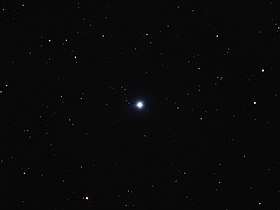Phi Herculis
Phi Herculis (φ Her) is a binary star[4] system in the northern constellation of Hercules. Based upon an annual parallax shift of 15.99 mas as seen from Earth,[1] it is located around 204 light years from the Sun. With a combined apparent visual magnitude of 4.24,[2] it is bright enough to be seen with the naked eye.
 φ Herculis in optical light | |
| Observation data Epoch J2000.0 Equinox J2000.0 (ICRS) | |
|---|---|
| Constellation | Hercules |
| Right ascension | 16h 08m 46.17745s[1] |
| Declination | +44° 56′ 05.6663″[1] |
| Apparent magnitude (V) | 4.24[2] |
| Characteristics | |
| Spectral type | B9VspHgMn[3] + A8V[4] |
| U−B color index | −0.23[2] |
| B−V color index | −0.06[2] |
| Astrometry | |
| Radial velocity (Rv) | −16.3±0.4[5] km/s |
| Proper motion (μ) | RA: −26.63[1] mas/yr Dec.: +36.76[1] mas/yr |
| Parallax (π) | 15.99 ± 0.45[1] mas |
| Distance | 204 ± 6 ly (63 ± 2 pc) |
| Absolute magnitude (MV) | A: 0.100 ± 0.059 B: 2.670 ± 0.074[6] |
| Orbit[6] | |
| Period (P) | 564.834±0.038 d |
| Semi-major axis (a) | 32.027±0.028 mas |
| Eccentricity (e) | 0.52614±0.00086 |
| Inclination (i) | 9.1±0.4° |
| Longitude of the node (Ω) | 190.4±1.4° |
| Periastron epoch (T) | 2450121.43 ± 0.20 JD |
| Argument of periastron (ω) (secondary) | 350.3±1.4° |
| Semi-amplitude (K1) (primary) | 2.772±0.073 km/s |
| Semi-amplitude (K2) (secondary) | 8.1[4] km/s |
| Details | |
| φ Her A | |
| Mass | 3.05±0.24[6] M☉ |
| Luminosity | 72[7] L☉ |
| Surface gravity (log g) | 4.05±0.15[4] cgs |
| Temperature | 11,525±150[4] K |
| Metallicity [Fe/H] | −0.03[6] dex |
| Rotational velocity (v sin i) | 8.0±1.0[4] km/s |
| Age | 210[6] Myr |
| φ Her B | |
| Mass | 1.614±0.066[6] M☉ |
| Surface gravity (log g) | 4.30±0.15[4] cgs |
| Temperature | 8,000±150[4] K |
| Rotational velocity (v sin i) | 50.0±3.0[4] km/s |
| Other designations | |
| Database references | |
| SIMBAD | data |
This is a single-lined spectroscopic binary star system with an orbital period of 564.8 days and an eccentricity of 0.526.[6] The primary, component A, is a B-type main sequence star with a stellar classification of B9VspHgMn.[3] It is a chemically peculiar star of the type called a mercury-manganese star.[4] The star is tentatively cataloged as an Alpha2 Canum Venaticorum variable.[9]
The secondary, component B, was first separated via interferometry in 2004.[10] It is an A-type main sequence star of class A8V.[4] The magnitude difference between the two components is 2.64.[10]
References
- van Leeuwen, F. (2007), "Validation of the new Hipparcos reduction", Astronomy and Astrophysics, 474 (2): 653–664, arXiv:0708.1752, Bibcode:2007A&A...474..653V, doi:10.1051/0004-6361:20078357.
- Mermilliod, J.-C. (1986), "Compilation of Eggen's UBV data, transformed to UBV (unpublished)", Catalogue of Eggen's UBV Data, SIMBAD, Bibcode:1986EgUBV........0M.
- Abt, Helmut A.; Morrell, Nidia I. (1995), "The Relation between Rotational Velocities and Spectral Peculiarities among A-Type Stars", Astrophysical Journal Supplement, 99: 135, Bibcode:1995ApJS...99..135A, doi:10.1086/192182.
- Zavala, R. T.; et al. (February 2007), "The Mercury-Manganese Binary Star φ Herculis: Detection and Properties of the Secondary and Revision of the Elemental Abundances of the Primary", The Astrophysical Journal, 655 (2): 1046–1057, arXiv:astro-ph/0610811, Bibcode:2007ApJ...655.1046Z, doi:10.1086/510108.
- de Bruijne, J. H. J.; Eilers, A.-C. (October 2012), "Radial velocities for the HIPPARCOS-Gaia Hundred-Thousand-Proper-Motion project", Astronomy & Astrophysics, 546: 14, arXiv:1208.3048, Bibcode:2012A&A...546A..61D, doi:10.1051/0004-6361/201219219, A61.
- Torres, Guillermo (June 2007), "Astrometric-Spectroscopic Determination of the Absolute Masses of the HgMn Binary Star φ Herculis", The Astronomical Journal, 133 (6): 2684–2695, arXiv:astro-ph/0703193, Bibcode:2007AJ....133.2684T, doi:10.1086/516756.
- McDonald, I.; et al. (2012), "Fundamental Parameters and Infrared Excesses of Hipparcos Stars", Monthly Notices of the Royal Astronomical Society, 427 (1): 343–57, arXiv:1208.2037, Bibcode:2012MNRAS.427..343M, doi:10.1111/j.1365-2966.2012.21873.x.
- "phi Her". SIMBAD. Centre de données astronomiques de Strasbourg. Retrieved 2017-04-05.
- Kazarovets, E. V.; et al. (1999), "The 74th Special Name-list of Variable Stars", Information Bulletin on Variable Stars (4659), Bibcode:1999IBVS.4659....1K.
- Zavala, R. T.; et al. (December 2004), "Detection of the Secondary of the HgMn star Phi Herculis with the Navy Prototype Optical Interferometer", Bulletin of the American Astronomical Society, 36: 1527, Bibcode:2004AAS...20510715Z.